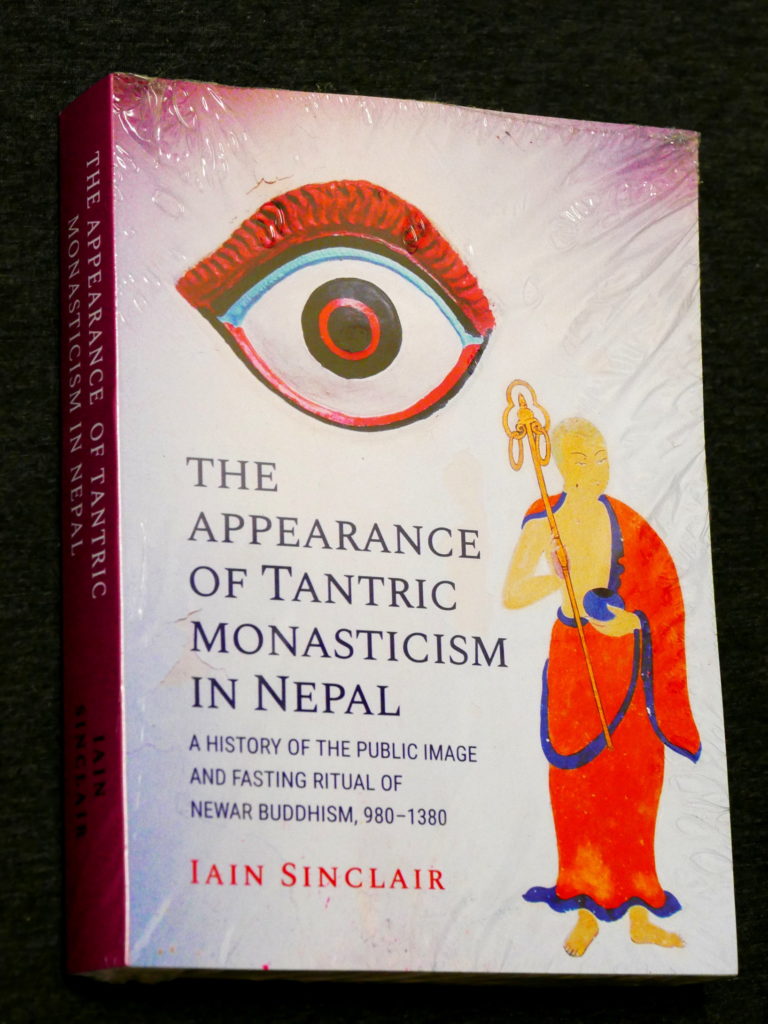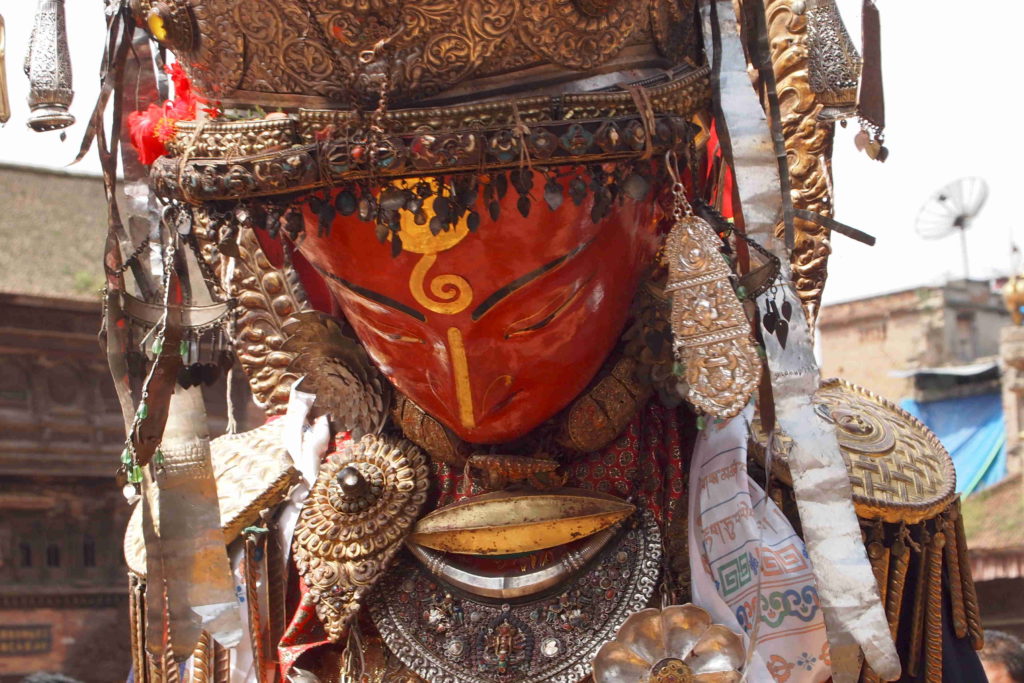Erin Hillary Epperson. 2017. ‘Kālidāsa in Tibet: Messenger Poetry in Translation.’ PhD diss., University of Chicago. [repo (URI): hdl.handle.net/11417/527] [PDF]. 298 pp. Continue reading “Epperson (2017), Kālidāsa in Tibet”
McKeown (2018), Śāriputra and the End of Late Indian Buddhism
Arthur McKeown. 2018/6/30. Guardian of a Dying Flame: Śāriputra (c. 1335–1426) and the End of Late Indian Buddhism. Harvard Oriental Series 89. Cambridge, MA: Harvard University Press. 450 pp. ISBN 9780674984356. USD 50.00. [official site]
From the Abstract: This study describes later Indian Buddhism through a detailed examination of the life of Śāriputra (c. 1335–1426), the last known abbot of the Bodhgayā Mahāvihāra, whose very presence extends Indian Buddhism by two centuries. This work also provides a view into the legacy of Indian Buddhism in fifteenth-century Nepal, Tibet, and China. Continue reading “McKeown (2018), Śāriputra and the End of Late Indian Buddhism”
Furger (2017), The Gilded Buddha
Alex R. Furger. 2017. The gilded Buddha: The traditional art of the Newar metal casters in Nepal, with a contribution by Ratna Jyoti Shakya. Basel/Frankfurt a. M.: LIBRUM Publishers & Editors. ISBN: 978-3-906897-06-6. DOI:10.19218/3906897066. [official] [PDF 🔓]
Note: This extraordinary book covers almost every conceivable aspect of metalworked image production in the Newar Buddhist community.

McGrath (2017), Buddhism and Medicine in Tibet
William McGrath. 2017. ‘Buddhism and Medicine in Tibet: Origins, Ethics, and Tradition’. PhD diss., University of Virginia. 264 pp. DOI:10.18130/V39H1N [PDF]
From the Abstract: Primarily focusing on the literary contributions made by the Drangti family at the Sakya Medical House, the present dissertation demonstrates the process in which the Tibetan medical tradition transitioned from controversy, competition, and change, to a narratively unified set of theories and practices that came to be taught at Buddhist institutions throughout the Tibetan plateau. Continue reading “McGrath (2017), Buddhism and Medicine in Tibet”
AABS seminar series 1 (2018), Sydney
Australian Association of Buddhist Studies seminar series, Semester 1, 2018. Meditation, Mind, and Healing: From India to Tibet and Beyond. Lecture Theatre S325, John Woolley Building, University of Sydney.
1. Trauma and Time: Tibetan Medical Responses to Nepal’s 2015 Earthquakes
Sienna R. Craig
Dartmouth College, USA
Wednesday 7 March, 6:00-7:30pm
2. Meditation in Tibetan Buddhism: Mind, Mahāmudrā and the Rhetoric of Immediacy
Jim Rheingans
University of Sydney
Thursday 15 March, 6:00-7:30pm
3. Facts or Fakes? Reconsidering Śāntideva’s Names, Life, and Works
Akira Saito
International College for Postgraduate Buddhist Studies, Tokyo
Thursday 22 March, 6:00-7:30pm
Mochizuki, Dīpaṃkarāśrījñāna studies
Mochizuki, Kaie 望月 海慧. [2016]. Diipamkarashuriijunyaana kenkyuu ディーパンカラシュリージュニャーナ研究 [Dīpaṃkarāśrījñāna studies]. PhD diss., Rissho University 立正大学. 1242 pp. URI: hdl.handle.net/11266/5774 [PDF]
Note: Contains critical editions of texts in Tibetan attributed to “Atiśa” Dīpaṃkarāśrījñāna, primarily those not focused on tantras, together with Japanese translations. Continue reading “Mochizuki, Dīpaṃkarāśrījñāna studies”
Sinclair (2016), The appearance of tantric monasticism in Nepal
 Iain Sinclair. 2016. ‘The appearance of tantric monasticism in Nepal: a history of the public image and fasting ritual of Newar Buddhism, 980-1380’. Monash University, Melbourne: PhD diss. 418 pp., 90 illustrations, 27 tables. DOI:10.4225/03/58ab8cadcf152
Iain Sinclair. 2016. ‘The appearance of tantric monasticism in Nepal: a history of the public image and fasting ritual of Newar Buddhism, 980-1380’. Monash University, Melbourne: PhD diss. 418 pp., 90 illustrations, 27 tables. DOI:10.4225/03/58ab8cadcf152
Contents
Continue reading “Sinclair (2016), The appearance of tantric monasticism in Nepal”
Wollein (2017), The Mūl Dīpaṅkara shrine
Andrea Wollein. 2017. ‘An ethnographic study of the Mūl Dīpaṅkara shrine in Bhaktapur (Nepal): the relationship between people and place’. University of Vienna: M.A. thesis (Masterstudium Kultur u. Gesellschaft des neuzeitlichen Südasiens). 189 pp., 87 figures. URN: nbn:at:at-ubw:1-20536.38953.228466-1 [official notice] [author: facebook]

Abstract: This thesis presents locality specific research in the form of an ethnography that draws both from fieldwork and published scholarly literature. The inter-disciplinary research is contextualized within the wider field of South Asian Studies and pertains to Himalayan, Buddhist and Newar Studies as well as to Tibetology. It is specifically concerned with the socioreligious dimension of Newar Buddhist monasteries (Skrt. vihāra, New. bāhā and bahī), the Buddhist deity Dīpaṅkara and the configuration of the relationship between the two of them as found in the setting of the Mūl Dīpaṅkara shrine in Bhaktapur. Continue reading “Wollein (2017), The Mūl Dīpaṅkara shrine”
Ringpapontsang (2016), Qubilai & ’Phags pa
Ringpapontsang, Tenzin Choephak. 2016. ‘Conquering the Conqueror: Reassessing the Relationship between Qubilai Khan and ’Phags pa Lama’. PhD diss., Australian National University. 251 pp. URI: http://hdl.handle.net/1885/114562 [PDF]
NB: Contains translations of the basic text of ’Phags pa’s Advice to a King and a commentary, Shes rab gzhon nu’s Rgyal po la gdams pa’i rab tu byed pa’i rnam par bshad pa gsung rab gsal ba’’i rgyan, Sa skya bka’ ’bum, TBRC W22271. (Many citations in the notes are to cut & pasted URLs, rather than robust conventional citations to published works.)
Richardson (2016), Murals at Shalu
Richardson, Sarah Aoife. 2016. ‘Painted Books for Plaster Walls: Visual Words in the Fourteenth-century Murals at the Tibetan Buddhist Temple of Shalu.’ PhD diss., University of Toronto. 271+146+186 pp. URI: http://hdl.handle.net/1807/73147.
From the Abstract: Elaborate mural paintings made after a major renovation of the temple in the early fourteenth century included long Tibetan inscriptions, displaying sometimes large passages of Tibetan sacred texts as part of their communicative pictorial program. By variously projecting books onto the walls, the temple’s abbot, Butön Rinchen Drup (Bu ston rin chen ‘grub, 1290-1364) placed new textual collections, inherently scholastic and elite projects, assertively into a more public domain.

